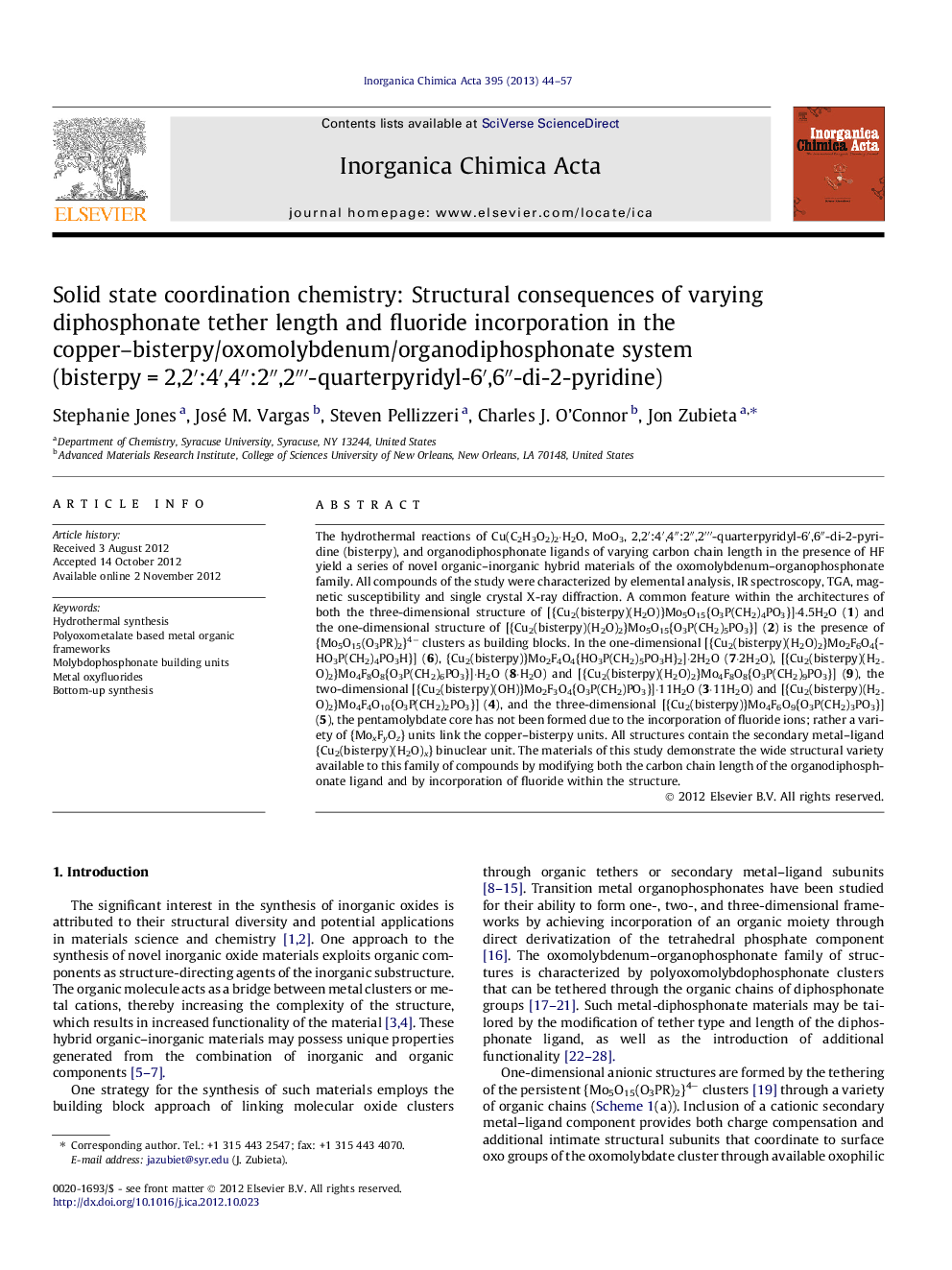| Article ID | Journal | Published Year | Pages | File Type |
|---|---|---|---|---|
| 1308425 | Inorganica Chimica Acta | 2013 | 14 Pages |
The hydrothermal reactions of Cu(C2H3O2)2·H2O, MoO3, 2,2′:4′,4″:2″,2′″-quarterpyridyl-6′,6″-di-2-pyridine (bisterpy), and organodiphosphonate ligands of varying carbon chain length in the presence of HF yield a series of novel organic–inorganic hybrid materials of the oxomolybdenum–organophosphonate family. All compounds of the study were characterized by elemental analysis, IR spectroscopy, TGA, magnetic susceptibility and single crystal X-ray diffraction. A common feature within the architectures of both the three-dimensional structure of [{Cu2(bisterpy)(H2O)}Mo5O15{O3P(CH2)4PO3}]·4.5H2O (1) and the one-dimensional structure of [{Cu2(bisterpy)(H2O)2}Mo5O15{O3P(CH2)5PO3}] (2) is the presence of {Mo5O15(O3PR)2}4− clusters as building blocks. In the one-dimensional [{Cu2(bisterpy)(H2O)2}Mo2F6O4{HO3P(CH2)4PO3H}] (6), {Cu2(bisterpy)}Mo2F4O4{HO3P(CH2)5PO3H}2]·2H2O (7·2H2O), [{Cu2(bisterpy)(H2O)2}Mo4F8O8{O3P(CH2)6PO3}]·H2O (8·H2O) and [{Cu2(bisterpy)(H2O)2}Mo4F8O8{O3P(CH2)9PO3}] (9), the two-dimensional [{Cu2(bisterpy)(OH)}Mo2F3O4{O3P(CH2)PO3}]·11H2O (3·11H2O) and [{Cu2(bisterpy)(H2O)2}Mo4F4O10{O3P(CH2)2PO3}] (4), and the three-dimensional [{Cu2(bisterpy)}Mo4F6O9{O3P(CH2)3PO3}] (5), the pentamolybdate core has not been formed due to the incorporation of fluoride ions; rather a variety of {MoxFyOz} units link the copper–bisterpy units. All structures contain the secondary metal–ligand {Cu2(bisterpy)(H2O)x} binuclear unit. The materials of this study demonstrate the wide structural variety available to this family of compounds by modifying both the carbon chain length of the organodiphosphonate ligand and by incorporation of fluoride within the structure.
Graphical abstractConventional hydrothermal conditions have been exploited in the preparation of a series of novel organic–inorganic hybrid materials of the oxomolybdenum–organodiphosphonate family. By varying the diphosphonate carbon chain length and the incorporation of fluoride within the structure, nine compounds were synthesized whose structures and thermal and magnetic properties are discussed.Figure optionsDownload full-size imageDownload as PowerPoint slideHighlights► Hydrothermal synthesis of organic–inorganic hybrids of the oxomolybdenum–organophosphonate family. ► Structural consequences of substitution of cluster oxo-groups with fluoride donors. ► Structural influences of phosphonate tether length. ► Identification of novel molybdenum oxyfluoride cluster building units, {MoxFyOz}. ► Novel materials of the evolving class of polyoxometalate-based metal organic frameworks (POMOFs).
